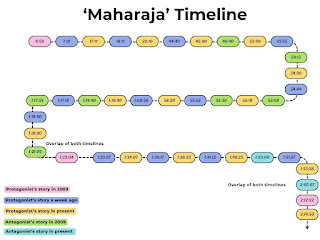In Literature and in movies, there are many different ways to tell a story. It could be in chronological order or using techniques like Flashback. It is said by many, that Shakespeare never wrote any original story and his popularity can be credited to his unique method of storytelling. These methods of non-linear storytelling were famous since the time of Greek plays. Playwrights like Sophocles used these methods to create plays like ‘Oedipus Rex’, which are famous even today. Similarly, in our movies many such techniques are used to create mystery and making the film more intriguing. These methods engage the audience with the movie as they are kept wondering about the storyline. This is done through use of methods like Bookend, Flashback, Embeded narratives or story within a story, two timeline, and many more. In this blog, we shall analyse the narrative frames Three different films: Life of pi, Slumdog millionaire, and Maharaja.
This blog is a thinking activity assigned by Barad Sir. For more information, check out this blog - Film studies: An Introduction
To understand types of frame narrative and why they are used, check out this video -
Narrative Frame of Life of Pi
‘Life of Pi’ (2012) is a film directed by Ang Lee, Based on the novel of the same name by Yann Martel. It tells the story of Pi Patel, A young Indian boy who survived a shipwreck in the Pacific Ocean. He is stranded on the sea with a Bengal tiger named Richard Parker. This film was widely acclaimed for its stunning visual effects and compelling storytelling.
‘Life of Pi’ tells the story of sea adventure in a dual-layered narrative. Here the use of Flashback technique is seen. The movie begins with Pi Patel telling his story to the author. The sea adventure is already in the past and Pi recounts it, while the audience sees it as flashback. This method establishes connection of the audience with the character because it feels like he is sharing his personal story directly with us. It also provides an introspective layer to the narrative.
This technique makes the audience question Pi’s credibility and whether he is an unreliable narrator. Later in the movie when Pi presents another version of the story where all the Animal characters are actually people, it gives the audience one last twist.
For better understanding of this frame narrative, check out this timeline -
Narrative Frame of Slumdog Millionaire
‘Slumdog Millionaire’ (2009) is a British-Indian drama film directed by Danny Boyle. The story follows Jamal Malik, an 18-year-old orphan from the slums of Mumbai, who becomes a contestant on the Indian version of “Who Wants to Be a Millionaire?” Despite his lack of formal education, Jamal answers each question correctly, drawing suspicion of cheating. Through a series of flashbacks, the film reveals how various experiences in Jamal’s tumultuous life provided him with the knowledge needed to answer the questions. The film explores themes of destiny, love, and the harsh realities of life in the slums, ultimately celebrating the triumph of the human spirit. “Slumdog Millionaire” won multiple Academy Awards, including Best Picture and Best Director.
In this film, we can see three timelines. One where Jamal is being interrogated by the police, one where he is playing the game show and third where we see glimpse of his past life that justifies how he knows the answer to any particular question. The movie jumps between these three timelines. This is called parallel timelines. To understand it better, check out this timeline.
Narrative Frame of Maharaja
‘Maharaja’ (2024) is a Tamil-language film directed by Nithilan Swaminathan. It stars Vijay Sethupathi in the titular character. It tells the story of a barber who goes to police station to complain about his missing dustbin. He is ridiculed by the officers and gets humiliated as well. However, it is filled with hidden twists and by the end becomes a dynamic narrative.
The narrative frame of this film is a tricky one. Due to hidden twists the narrative is divided into 5 parts. One timeline follows the protagonist’s present story, his story one week ago and his story in the year 2009. Another timeline follows the Antagonist’s present story and his story in the year 2009. Two times in the movie, these timelines are overlapping. The position or chronological order of these timelines are not specified by the makers. This means that when scene shifts, the audience does not know for sure where the action is happening. Later in the film, these confusions are resolved and it shocks the audience.
To better understand these, check out the following timeline graph.
Comparison of the Narratives
In comparing the narrative structures of "Life of Pi," "Slumdog Millionaire," and "Maharaja," it is evident that each film employs distinctive techniques to enhance their storytelling, engaging audiences in unique ways.
"Life of Pi" utilises a reflective framing device where the adult Pi recounts his extraordinary survival story to a writer, blending past and present seamlessly. This structure allows for deep philosophical musings and character development, as well as the exploration of themes like faith, survival, and the nature of truth. The dual versions of Pi's story emphasize the subjective nature of reality and belief, leaving a lasting impact on the audience.
"Slumdog Millionaire," on the other hand, employs a non-linear narrative interwoven with flashbacks triggered by questions on a game show. This structure creates a dynamic and suspenseful storyline, gradually revealing the protagonist Jamal's life experiences and how they have shaped his knowledge and resilience. The parallel storylines of the game show, Jamal's past, and his police interrogation provide a multifaceted view of his journey, highlighting social issues such as poverty and class disparity while maintaining a gripping narrative flow.
"Maharaja," uses a new technique where an important element of the story is cleverly hidden from the audience. In the first part of the movie, the audience finds the narrative ridiculous as well as redundant. However, soon the timeline becomes a little clear and people realise that the characters do not exist at the same time. This happens at the first overlap of the narrative. That’s when we find out that the glimpses of the antagonist were from his past and soon the story begins to unravel.
In conclusion, while "Life of Pi" and "Slumdog Millionaire" employ complex narrative structures that interweave different timelines and perspectives to enrich their storytelling and thematic depth, "Maharaja" uses a technique of hiding the essential details. Each film's narrative technique is tailored to its story's needs, effectively engaging the audience and enhancing the cinematic experience. These diverse approaches to narrative structure demonstrate the versatility and creativity inherent in film storytelling.







Comments
Post a Comment